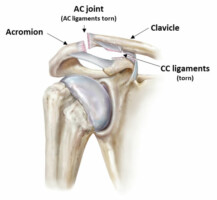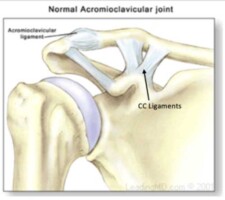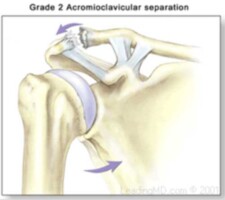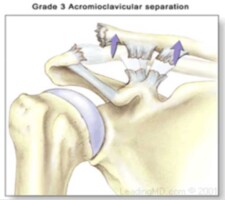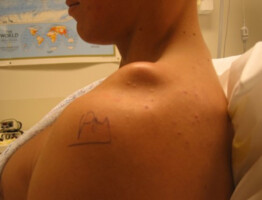AC Joint Separation Overview
An AC joint separation is a common injury among physically active individuals. A separated shoulder is not truly an injury to the shoulder joint, but instead involves the acromioclavicular joint, otherwise known as the AC joint. In an AC separation injury, the clavicle (collarbone) separates from the scapula (shoulder blade), and is commonly caused by a fall directly on the shoulder or a direct blow. Dr. Peter Millett is a leading orthopedic shoulder specialist in the treatment of AC joint separations.
A separated shoulder is most commonly experienced when an individual falls directly on the "point" of the shoulder blade. The fall can be responsible for injuring the surrounding AC joint ligaments, the acromioclavicular ligament (AC) and the two coracoclavicular ligaments (CC), which stabilize the AC joint.
An AC separation injury can range from a mild separated shoulder to a complete tear of both the AC ligament and CC ligaments. Many physicians range the injuries on a Grade I-III scale.
What are the Symptoms of a Separated Shoulder?
An AC joint separation has a wide range of symptoms dependent on the grade of injury.
- Grade I: A slight stretch or partially torn AC ligament may cause joint tenderness, bruising and minor shoulder pain.
- Grade II: A completely torn AC ligament and intact CC ligaments may cause moderate to severe shoulder pain, swelling and a small bump on the top of the shoulder.
- Grade III: Completely torn AC ligament and CC ligaments may cause swelling, severe shoulder pain, shoulder deformity, and instability. Often a popping sound is heard at the time of injury.
How is an AC Joint Separation Diagnosed?
A separated shoulder is easy to diagnose when the injury causes deformity. When deformity is not present, a thorough physical examination must be performed to locate the area of pain and to compare the injured arm's position to the uninjured arm. During the physical examination, Dr. Millett will gently feel the bones and soft tissues in the injured area, evaluate the range of motion and perform tests to locate specific areas of shoulder pain and weakness.
How is a Separated Shoulder Treated?
AC joint separation treatment depends on the injury grade. Many patients will experience a full recovery with non-operative treatment which includes rest, ice, shoulder immobilization, pain and anti-inflammatory medications, and physical therapy.
Surgery may be recommended by Dr. Millett if the AC separation is too severe or if non-operative treatment measures do not alleviate the separated shoulder symptoms. A variety of surgical measures may be used. The most common technique involves the reconstruction of the CC ligaments and performing a distal clavicle resection. During this procedure, Dr. Millett removes a tiny part of the collarbone, then transfers the AC ligament from the bottom of the shoulder blade to the end of the prepared collarbone, replacing the torn ligament. Dr. Millet can discuss the different surgical options individually, depending on the specific injury.
For additional information on an AC joint separation, or to learn more about treatment options for this shoulder condition, please contact Dr. Peter Millett.

